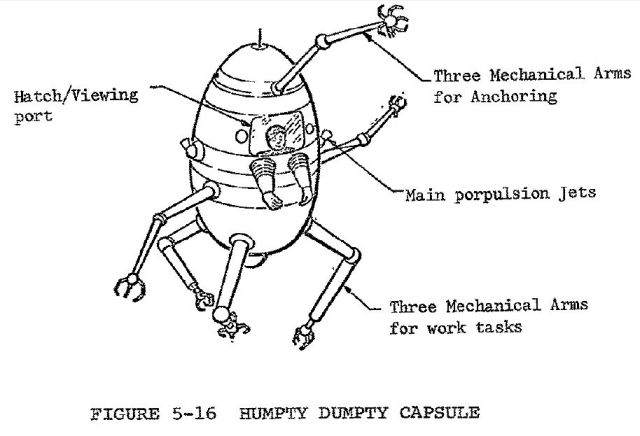SANTA MONICA DIVISION
DOUGLAS AIRCRAFT COMPANY, INC.
SANTA MONICA, CALIFORNIA
NONANTHROPOMORPHIC SPACE SUIT
The "Humpty-Dumpty, " a nonanthropomorphic space suit (capsule), consists of an egg-shaped cylinder capable of supporting at least one man who is engaged in assembly, maintenance, or similar-type tasks in outer space (see figure 1). The capsule itself contains an ecological system capable of maintaining near ideal environmental conditions for approximately 30 hours. On the internal walls of the vehicle there are rotating panels which allow the astronaut complete monitoring of the environmental conditions of the vehicle and also afford him direct feedback as to the ongoing state of affairs of his propulsion system and many mechanical appendages. The astronaut sitting at his central control panel map at his discretion, rotate the wall panels to a position which is most advantageous to him for the direction in which he is facing. The rotating panels are necessitated by the fact that the viewport of the vehicle completely circles the astronaut. Due to radiation hazards the viewport is covered by a rotating shield which may be positioned by the astronaut to face in any direction.
Fastened to this shield are two floodlights for operations conducted in the dark. Three of the specialized mechanical arms of this "astro-tug" maybe rotated through 360 degrees around the tug and thus afford the occupant complete maneuverability without actually rotating the vehicle itself. These specialized arms have specially equipped hands composed of tools which may be utilized in outer space—e.g.,
drill, acetylene torch, paint and plastic applicator, screw driver, etc. Three fixed arms on the base of the vehicle are theoretically constructed to accomplish operations which call for powerful movements similar to those necessary for positioning two fuel tanks together, holding the astro-tug to a second vehicle while construction or maintenance is performed, and the like. Gripping is done through the use of finger-like clamps on the outer portion of the limb.
To effect propulsion and guidance of the system, three nozzles on rotating spheres are used.
Two of these nozzles are located on the "x" center of gravity axis. These are responsable for the main propulsion of the unit. The third unit is at the bottom of the capsule and may be used to correct maneuvers conductive to tumbling or, if this vehicle is to be used in a gravity environment, this third unit may be used to suspend the capsule above the surface of the gravity environment.
While the astronaut is given complete manual control of the vehicles through the propulsion system, he may also utilize the inertial platform of the capsule to maintain any position automatically and thus free all six mechanical arms for a complex task. Control of all six mechanIcal arms is accomplished through the central control panel via fingertip control. The arms act in response to any movement of the hand.
Two internally sealed, anthropomorphic-type arms have been included on the vehicle so that, in case there is some specialized or precise type of task to be done which is not a direct capability of the mechanical arms, the operator may insert his own arms into these flexible shieldings and perform the operation.
Access to this vehicle is obtained either through a hatch constructed in the plexiglas front or through a doubly scaled hatch on the top the capsule.
PROJECT MERCURY CONVERTED CAPSULE
A second concept for a nonantropomorphic-type space suit would essentially be constructed from off-the-shelf items. It would be possible to utilize the Project Mercury Space Capsule and re-entry body as a space suit for assembly, maintenance, or similar-type functions. To do this, the major additions to the system would merely be a translucent plastic observation port on the forward portion of the capsule and an assembly of mechanical arms to be attached in place of the parachute package. These arms could in turn be foldable into their shaft holder. Figure 2 illustrates the design configuration. Modifications of the capsule world also be necessary in that the fuel tanks for propulsion would have to be enlarged to allow maneuvers in space. The interior would have tope slightly rearranged to allow inclusion of controls and panels associated with the mechanical appendages. While there are many disadvantages to this system (e.g., provisions for stabilization of attachments to a second vehicle while accomplishing tasks are presently not considered feasible), the most immediate advantages are the decreased cost of development and the fact that this vehicle may be included in a satellite system for utilisation as an escape vehicle which is readily altered, while spaceborne, into an astro-tug.
The feasibility of a capsule of this nature must be considered in any future analysis of an extra-vehicular space suit.
Source: "Survey of Remote Handling in Space", D. Frederick Baker, USAF, 1962

• Douglas Aircraft Company Humpty Dumpty Space Capsule
The Humpty Dumpty capsule is another non-anthropomorphic concept. The craft is egg-shaped and is capable of supporting one man in space for approximately 30 hours in a self-contained environment. Three stabilizer and three manipulator arms are mounted to the outside of the craft.
There are also two anthropomorphic gloves mounted on the craft through which the astronaut may perform certain functions.
This concept (rigure 5-16) was also proposed about 1960.
See other early Teleoperators here.
See other early Lunar and Space Robots here.